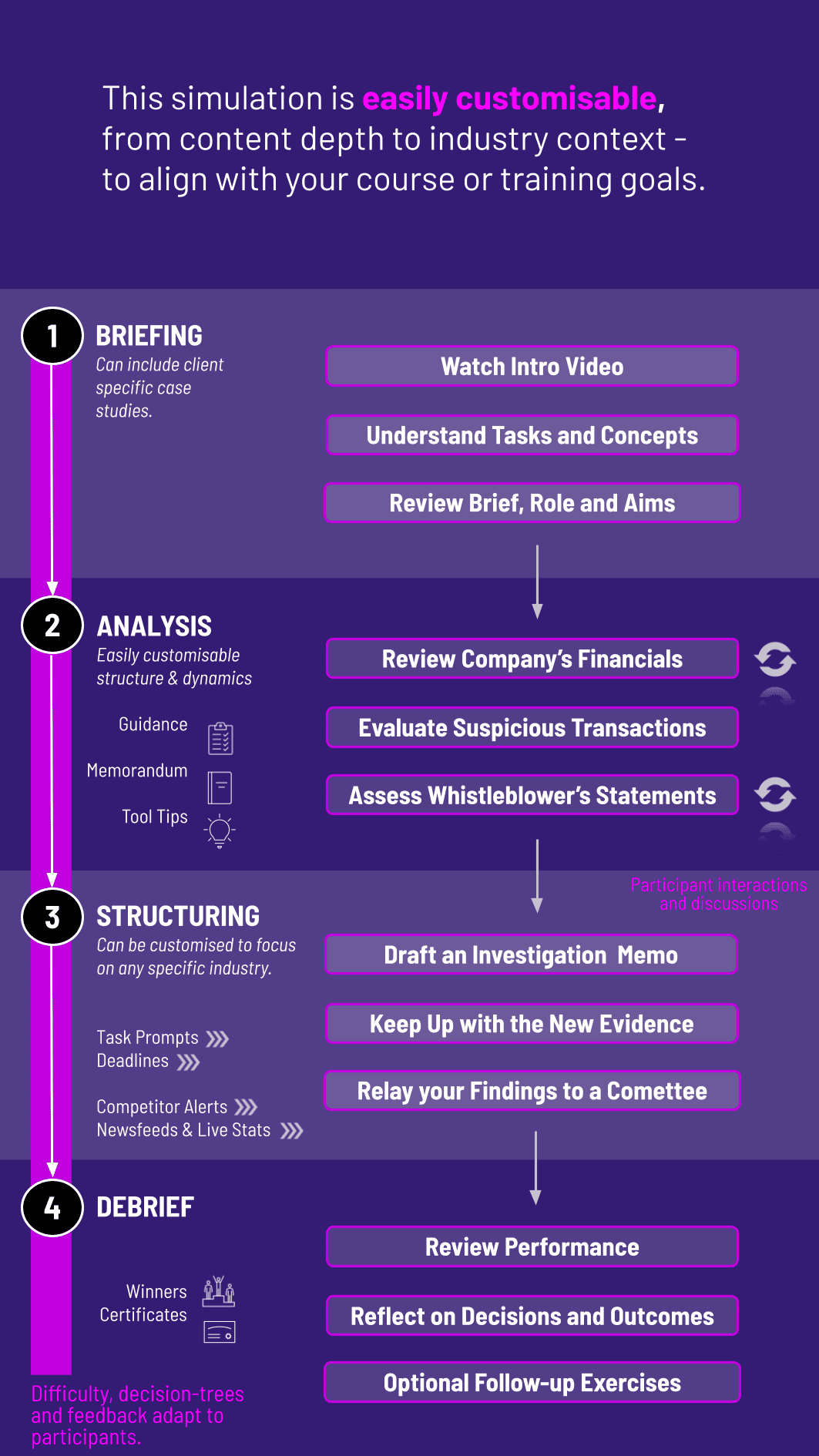
In this hands-on Forensic Accounting Simulation, participants step into the role of forensic auditors investigating financial irregularities. They analyse records, uncover fraud, and present findings with clarity and professionalism.
Fraud Detection Techniques
Red Flag Indicators and Pattern Recognition
Revenue Recognition and Expense Manipulation
Interviewing and Investigative Approaches
Document Review and Evidence Compilation
Legal and Regulatory Context
Ethical Boundaries and Whistleblower Protocols
Internal Controls and Risk Assessment
Report Writing and Board-Level Communication


Review company financials and operational documents for irregularities
Identify red flags across various departments and subsidiaries
Decide which transactions, records, or staff members require deeper scrutiny
Draft preliminary investigation memos
Respond to evolving case facts as new evidence or whistleblower tips emerge
Prepare a final report with clear findings and recommendations
Communicate insights to a mock audit committee or legal advisor
By the end of the simulation, participants will be able to:
Apply forensic techniques to identify and assess fraud risks
Analyse financial data to uncover inconsistencies and unusual patterns
Understand the ethical and legal responsibilities of forensic accountants
Distinguish between poor controls and intentional misstatements
Structure a forensic investigation process from start to finish
Practise interviewing approaches in simulated case scenarios
Improve professional report-writing for audit and legal contexts
Evaluate whistleblower statements and integrate into investigations
Communicate findings effectively to senior stakeholders
Collaborate with cross-functional teams during investigations
The simulation’s flexible structure ensures that these objectives can be calibrated to match the depth, duration, and focus areas of each program, whether in higher education or corporate learning.
This simulation can be run in teams or individually and is ideal for classrooms, corporate training, or assessment centres. Participants move through several investigative rounds, each with new information and growing complexity. Here’s how it works:
1. Receive a Case File or Brief: Each round starts with a scenario - often a tip-off, audit concern, or compliance issue. Participants receive a brief and supporting documents to review.
2. Examine the Evidence: They review financials, transaction logs, emails, and expense reports. The goal is to identify patterns or anomalies that require deeper digging.
3. Make Investigative Decisions: Participants choose areas to investigate, whom to question, and what to cross-check. They decide how to allocate limited time and resources.
4. Adapt to New Developments: As the case unfolds, new evidence is introduced - memos, whistleblower tips, or interview summaries. Participants update their strategy accordingly.
5. Compile and Present Findings: Each team (or individual) drafts a report or memo summarising findings, key risks, and next steps. This may be followed by a simulated boardroom presentation or audit committee Q&A.
6. Reflect and Repeat: The simulation continues over multiple rounds, each building on the last. Participants improve with each cycle - refining judgment, communication, and investigative logic.
Do I need to be an accounting expert to use this simulation? Not at all. A basic understanding of financial statements is enough. The simulation guides you through the rest.
What industries are represented in the cases? You’ll explore scenarios across sectors - retail, manufacturing, tech, and financial services.
Is this simulation suitable for law, ethics, or compliance courses? Yes. It works across disciplines and complements legal, ethical, or risk-focused modules.
Can participants practise writing a real forensic report? Yes. Final deliverables can include memos, summaries, or formal reports tailored to the course level.
Does the simulation include legal or whistleblower scenarios? Yes. Participants may have to navigate whistleblower reports or respond to audit/regulatory scrutiny.
Can the content be localised for different geographies? Absolutely. The simulation can be adapted for regional regulations and fraud norms.
Is the game competitive or collaborative? Both options are available. Teams can compete or work together based on your program’s goals.
How long does it take to run? Anywhere from 2 hours to multiple sessions over a semester - it’s fully adjustable.
Can I combine this with a technical accounting module? Yes. It pairs well with audit, reporting, internal controls, and financial analysis content.
Is this useful for corporate training? Definitely. It’s perfect for onboarding, internal audit upskilling, or compliance refresher programs.
Accuracy and relevance of red flags identified
Structure and clarity of investigative reports
Communication effectiveness under questioning
Ethical judgement and sensitivity to stakeholder impact
Responsiveness to evolving case details
Peer and self-assessments to reflect collaboration and adaptability
You can also include memo writing and debrief presentations as part of the assessment structure. Additionally, you can also add a built-in peer and self-assessment tool to see how participants rate themselves. This flexibility allows the simulation to be easily integrated by professors as graded courses at universities and by HR at assessment centres at companies.
Join this 20-minute webinar, followed by a Q&A session, to immerse yourself in the simulation.
or
Book a 15-minute Zoom demo with one of our experts to explore how the simulation can benefit you.